The recent `No Knot` 5-stringer restoration pointedly reminded the BRC founder of his website motto: All Banjos Deserve a Second Chance. Postponing plans to build a banjo for an upcoming art show, he earnestly set out to restore a dreary and deeply tarnished antique instrument that had been languishing for months under a table in the workshop.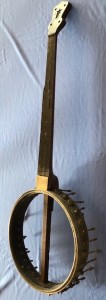
The fretboard and tuning pegs were gone, mother of pearl inlays in the peg head were fragmented or absent, no remnant of a head remained, and much of the hardware was pitted with rust. The base of the neck had a smudged plaque embossed with ” Puritan.”
Research revealed that this circa 1895 banjo was likely made in Chicago by the Lyon & Healy Company that also marketed similar 5 -stringers with plaques labeled “Mystic” or “President” and sometimes “Encore.” Unique structural features at the neck-rim junction indicate that this model was a student/intermediate level instrument.
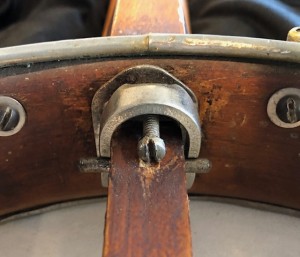
In comparison, some high end 5-stringers of that era had the familiar neck brace-cross pin used to stabilize the dowel stick-pot junction as seen in this circa 1900 banjo. It is not known when this mechanically dependable device was invented, but it is ubiquitous today and bears no patent data.
Less expensive turn of the century banjos, as seen in this archival picture from the BRC collection, frequently had only one or two wood screws across the pot or dowel stick-neck interface. A supplemental stout metal brace spanning the construct was not ornamental but integral in stabilizing the junction.
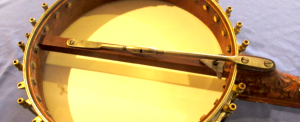
The “Puritan” had a well-secured and engraved buttress plate made of brass that reenforced the two wood screws hidden below it clasping the pot to the heel of the neck. 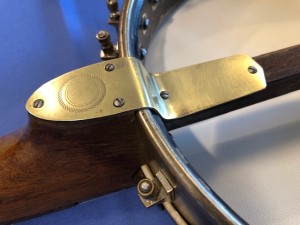
The inner wooden pot was “spun over” and clad with a German silver (nickel , copper, and zinc alloy) outer rim. Some collectors admire this shiny antique feature and the tone it reportedly imparts to the banjo. A new rosewood fretboard was fretted and installed, and it was modestly inlayed with mother of pearl. The recessed “Puritan” plaque at the base of the neck offered a profile that looks like a forerunner of the modern day `scooped` fingerboard.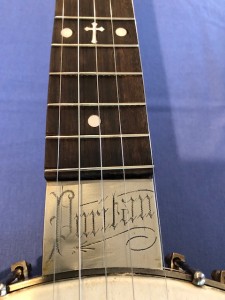
Clawhammer enthusiasts would probably concur that all banjos, especially an open-back treasure like this one, deserve a second chance.

No Comments